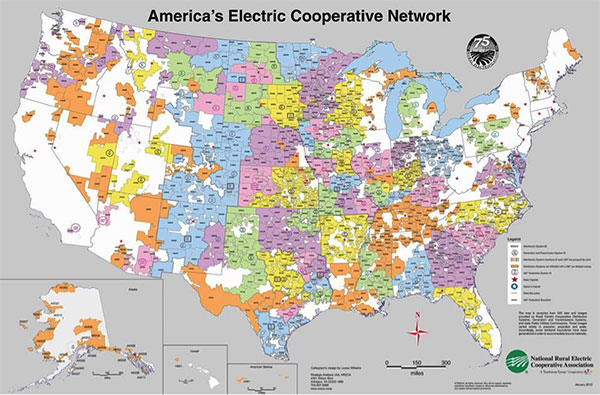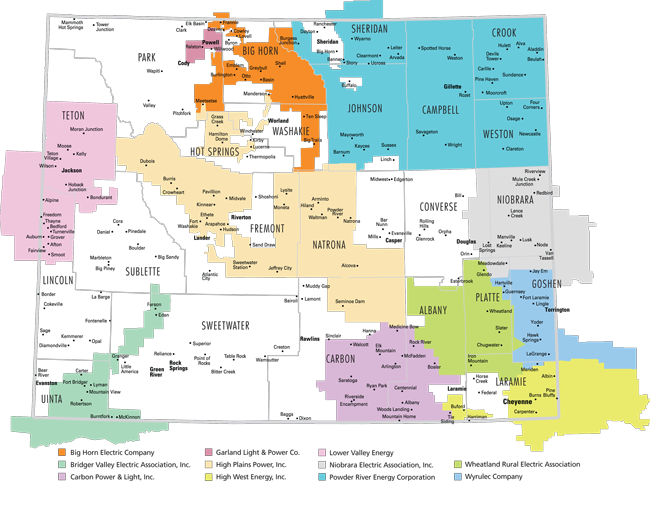As late as the mid-1930s, nine out of 10 rural homes were without electric service. The farmer milked his cows by hand in the dim light of a kerosene lantern. His wife relied on the wood range and washboard.
The unavailability of electricity in rural areas kept the economies in these places entirely and exclusively dependent on agriculture. Factories and businesses, of course, preferred to locate in cities where electric power was easily acquired. For many years, power companies ignored the rural areas of the nation.
The first official action of the federal government pointing the way to the present rural electrification program came with the passage of the Tennessee Valley Authority (TVA) Act in May 1933. This act authorized the TVA Board to construct transmission lines to serve “farms and small villages that are not otherwise supplied with electricity at reasonable rates.”
The idea of providing federal assistance to accomplish rural electrification gained ground rapidly when President Roosevelt took office in 1933. On May 11, 1935, Roosevelt signed Executive Order No. 7037 establishing the Rural Electrification Administration (REA). It was not until a year later that the Rural Electrification Act was passed, and the lending program that became the REA got underway.
Within four years following the close of the war, the number of rural electric systems in operation doubled, the number of consumers connected more than tripled, and the miles of energized line grew more than five-fold. By 1953, more than 90 percent of U.S. farms had electricity.
Today, about 99 percent of the nation’s farms have electric service. Most rural electrification is the product of locally-owned rural electric cooperatives that got their start by borrowing funds from the REA to build lines and provide service on a not-for-profit basis. Today the REA is the Rural Utilities Service (RUS) and is part of the U.S. Department of Agriculture.
Source: National Rural Electric Cooperative Association
The Wyoming Rural Electric Association represents 14 consumer-owned electric cooperatives throughout the state, in addition to three generation and transmission cooperatives (G&Ts).
Electric cooperatives are an integral part of the $370 billion U.S. electric utility industry. They play a critical role in the economy of local communities, states, and our nation as a whole.
Electric cooperatives are:
- Private, independent, non-profit electric utilities
- Owned by the customers they serve
- Incorporated under the laws of the states in which they operate
- Established to provide at‑cost electric service
- Governed by a board of directors elected from the membership which sets policies and procedures that are implemented by the co-op’s management
SEVEN COOPERATIVE PRINCIPLES:
- Voluntary and Open Membership
- Democratic Member Control
- Members’ Economic Participation
- Autonomy and Independence
- Education, Training, and Information
- Cooperation Among Cooperatives
- Concern for Community
Distribution cooperatives are the foundation of the rural electric network, delivering electricity to retail customers. G&Ts provide wholesale power to distribution co-ops through their own generation or by purchasing power on behalf of the distribution members.
In addition to providing electric service, electric co-ops support their communities by promoting development and revitalization projects, small businesses, job creation, improvement of water and sewer systems, and assistance in delivery of health care and educational services.

In the United States:
- 841 distribution and 65 G&T cooperatives serve an estimated 42 million people in 47 states
- Co-ops supply electricity to 18.5 million businesses, homes, schools, churches, farms, irrigation systems, and other establishments in 2,500 of the nation’s 3,141 counties
- Rural electric co-ops serve more than 12 percent of the nation’s meters
To perform their mission, electric cooperatives:
- Own assets worth $140 billion (distribution
and G&T co-ops combined)
- Own and maintain 2.5 million miles (or 42 percent) of the
nation’s electric distribution lines, covering three quarters of the nation’s landmass
- Deliver 11 percent of the total kilowatt hours sold in
the U.S. each year
- Generate nearly 5 percent of the total electricity produced in the U.S. each year
- Employ 70,000 people in the U.S.
- Retire $600 million in capital credits annually
- Pay $1.4 billion in state and local taxes annually
Compared with other electric utilities:
|
Consumers per mile |
Annual revenue per mile |
| Cooperatives |
7.4 |
$15,000 |
| Investor-owned utilities |
34 |
$75,500 |
| Publicly owned utilities |
48 |
$113,000 |
- Co-ops serve an average of 7.4 consumers per mile of line and collect annual revenue of approximately $15,000 per mile
- Investor-owned utilities average 34 customers per mile of line and collect $75,500 per mile
Publicly owned utilities, or municipals, average 48 consumers per mile of line and collect $113,000 per mile




